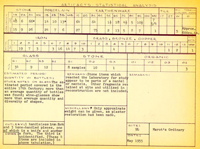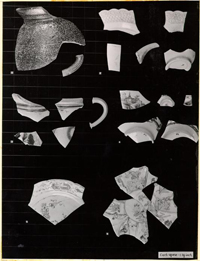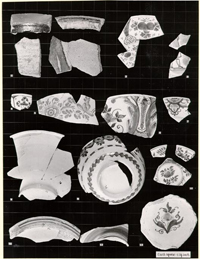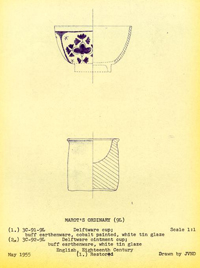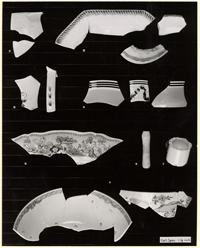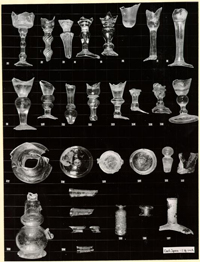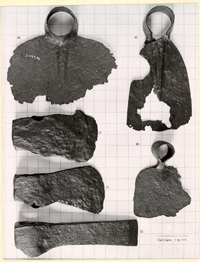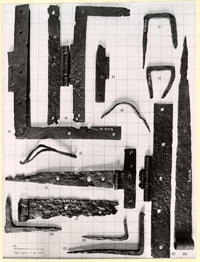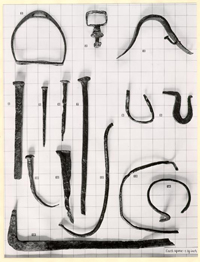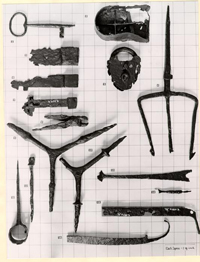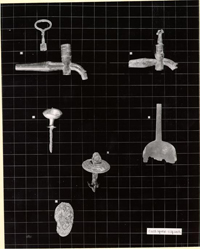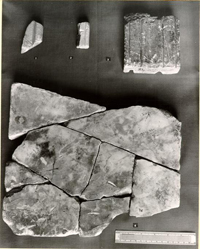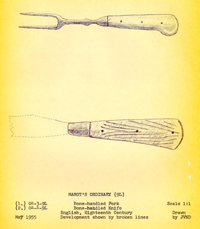Shields Tavern Archaeological Report, Block 9 Building 26B Lot 25 & 26
Originally entitled: "Marot's Ordinary Block 9, Parts of Colonial Lots Numbered 25 and 26, Archaeological Area 96 Williamsburg, Virginia"
Colonial Williamsburg Foundation Library Research Report Series - 1142
Colonial Williamsburg Foundation Library
Williamsburg, Virginia
1990
MAROT'S ORDINARY
BLOCK 9
PARTS OF COLONIAL LOTS NUMBERED 25 AND 26, ARCHAEOLOGICAL AREA 9L
WILLIAMSBURG, VIRGINIA
ARCHAEOLOGICAL LABORATORY REPORT
Office of Architectural Research
Architects' Office
Colonial Williamsburg
May 31, 1955
PREFACE
The following is a report upon the artifacts excavated from the site of Marot's Ordinary (9L), prepared in compliance with a request from the Curator.
The artifacts were excavated under the direction of Mr. James M. Knight, Archaeological Draftsman. The photographs were made by Mr. David Brooks of the Photographic Laboratory, while the drawings are the work of Mr. John V. N. Dunton, of the Archaeological Laboratory staff.
TABLE OF CONTENTS
| Title Page | 1 |
| Preface | 2 |
| Table of Contents | 3 |
| Historical Notes | 4 |
| Key to Statistical analysis of Artifacts(facing) | 5 |
| Statistical Analysis of Artifacts | 5 |
| 1.CERAMICS | 6 |
| Comments on Ceramics | 6 |
| Description of Ceramics | 8 |
| //Interleaved with Plates I - XI// | |
| 2.GLASS | 24 |
| Comments on Glass | 24 |
| Description of Glass | 26 |
| //Interleaved with Plates XII and XIII// | |
| 3.METAL | 32 |
| Comments on Metal | 32 |
| Description of Iron | 32 |
| //Interleaved with Plates XIV - XVII// | |
| Description of Brass and Bronze | 46 |
| Plate XVIII | |
| Description of Miscellaneous Metals: Pewter | 50 |
| 4.STONE & BRICK | 51 |
| Plate XIX | |
| 5.MISCELLANY | 54 |
| Comments on Tobacco Pipes and Wig-Curlers | 54 |
| Comments on Bone-Handled Cutlery | 55 |
| Plate XX |
HISTORICAL NOTES
The following brief notes upon the occupancy of the Marot's Ordinary site, consisting of Colonial Lot numbered 25, with part of Colonial Lot numbered 26, are derived from the research report upon this area.
The house which was standing upon this lot in 1708 was used almost continuously as an ordinary or coffee house until 1752, when part of the building became the shop of a merchant dealing in wine, tea, and chocolate. At various times from this period onward, parts of the building were occupied as lodgings. In the early 1770's, a tailor's shop was situated here, and a physician is known to have resided in a part of the house from 1772 to 1790. The western end of the building in 1770 was leased to a farrier and blacksmith. Fire destroyed the building in 1858. In 1861, and for a few years thereafter, a carriagemaker's shop was at this location. The site in later years was residential.
KEY TO STATISTICAL ANALYSIS OF ARTIFACTS
CERAMICS
| 1A | Brown Stoneware |
| 2A | White Salt Glaze |
| 3A | Gray Stoneware |
| MA | Miscellaneous Stoneware |
| 1B | Chinese Porcelain |
| 2B | Chinese Porcelain |
| (Polychrome Enameled) | |
| 3B | English Porcelain |
| MB | Miscellaneous Porcelain |
| 1C | Crude Earthenware |
| 2C | Slip-Decorated Ware |
| 3C | Delftware |
| 4C | Whieldon (Tortoiseshell, Pineapple, Cauliflower, Agate Ware) |
| 5C | Creamware |
| 6C | Blue and Green-Edged Ware |
| 7C | Hand-Painted Staffordshire Ware |
| 8C | Annular Ware |
| 9C | Transfer-Printed Staffordshire Ware |
| 10C | Indian Pottery |
| MC | Miscellaneous Pottery |
| 1T | Roofing Tile |
| 2T | Fireplace Tile |
| W | Wig-Curlers |
| P | Tobacco Pipes |
METAL
| 1. | Military Goods |
| 2. | Tools & Implements |
| 3. | Harness & Horse Furniture |
| 4. | Household Hardware |
| 5. | Cabinet Hardware |
| 6. | Builder's Hardware |
| 7. | Nails, Spikes |
| 8. | Hinges |
| 9. | Locks & Keys |
| 10. | Miscellaneous |
| 1. | Buckles |
| 2. | Ornaments |
| 3. | Spurs, Harness |
| 4. | Bronze Wine-Cocks |
| 5. | Buttons |
| 6. | Fire Irons |
| 7. | Cabinet Hardware |
| 8. | Watches, Clocks |
| 9. | Military Goods |
| 10. | Candlesticks & Snuffers |
| 11. | Household Utensils |
| 12. | Hardware |
| 13. | Miscellaneous |
| MM | Miscellaneous Metals |
GLASS
| G1 | Tableware (Wine Glasses, Tumblers, Decanters, Cruets, etc.) |
| G2 | Wine or Other Beverage Bottles |
| G3 | Vials (Medicine, Perfume) and other Fragile Containers |
| G4 | Miscellaneous |
| S1 | Brick |
| S2 | Marble |
| S3 | Other |
| 01 | Wood |
| 02 | Textile or Basketry |
| 03 | Leather |
| 04 | Bone and Ivory |
1. CERAMICS
Comments on Ceramics
Among the ceramic collections from the site of Marot's Ordinary, there are quantitatively a greater proportion of sherds common to the early and middle years of the Eighteenth Century, with a much smaller showing of types of ware that came into popularity late in that century and early in the Nineteenth Century. Inventories are extant which list the property left by two early keepers of this public house, Jean Marot, whose estate was settled on December 16, 1717, and his son-in-law, James Shields, whose possessions were inventoried on January 21, 1750/1751. Among Marot's ceramic property were such items as parcels or lots of earthenware, quantities of pipes, presumably tobacco pipes, "Juggs of Oyle", stone jugs, French brandy in pottle bottles - all being casual references, not particularly helpful in identifying these possessions with precision. One reference to "China Cupps", however, is taken to be a reference to Chinese porcelain, then a distinct novelty in Virginia, as its importation was just commencing. References in Shields' inventory to ceramics were scarcely more specific, although "China" was mentioned much more frequently than in the Marot inventory. For instance, in the Shields property listed as present "in the Hall" were included, among other items, six earthen tea cups, one pottle decanter and one pottle stone mug. The last two items could easily be brown stoneware or gray stoneware, but identification of "earthen tea cups" cannot be attempted. The finding 7 at this site of several mugs and a quantity of tobacco pipes, no less than the presence here of more than ordinary numbers of wine-glasses and wine bottles, are tangible indications linking this house with public entertainment.
The key to the statistical analysis of artifacts identifies the categories by which the ceramic and other artifacts are described in detail.
Description of Ceramics
Class 1A, Brown Stoneware:
Brown Stoneware, common to the Seventeenth and Eighteenth Centuries, is represented at this site by at least one heavy flat-bottomed Jug or jar; a narrow-mouthed jar with flaring lip; a jar lid fragment; parts of two jars of indeterminate shape; and by the basal fragment of one mug. Some of these sherds are illustrated in Plate I, No. 1.
(References are to page numbers in the text.)
- 1. Brown stoneware sherds - 8.
- 2. White salt glaze sherds - 9.
- 3. Gray stoneware sherds - 10.
- 4. Chinese porcelain sherds - 12.
- 5. Chinese porcelain (polychrome enameled) plate fragment, catalogued as 2B-18-9L, p. 13; also see Plate III.
- 6. Chinese porcelain (polychrome enameled) plate fragment, catalogued as 2B-17-9L, p. 13.
Class 2A, White Salt Glaze Stoneware:
White salt glazed table ware was developed in England early in the Eighteenth Century and was in vogue in Williamsburg by mid-century. Its popularity here continued as late as the American Revolution. An "orange-peel" surface, characteristic of all salt glazes, is particularly noticeable in white salt glaze ware. It has a white, vitreous body and frequently was potted into very thin shapes. This site has yielded parts of two plates, made in a mold and decorated on the marly with a conventionalized basketweave and leaf pattern; the spout and base of a teapot; and sherds of two deep cups, or mugs. Illustrative sherds are given in Plate I, No. 2.
10Class 3A, Gray Stoneware:
Gray stoneware, of characteristic German style and workmanship, and probably also of German origin, was a rough household and commercial ware of the Eighteenth Century, usually plentiful on Williamsburg house sites. A heavier, slightly different form of gray stoneware was being produced in America early in the Nineteenth Century; for example, as recently as 1850, and possibly later, Shenandoah County potteries were turning out examples in quantities, and this Nineteenth Century type frequently appears at Williamsburg sites.
Eighteenth Century examples bear boldly defined areas colored with intense cobalt-blue, against a light gray background, while Nineteenth Century workmanship usually can be distinguished from the earlier types by the application of cobalt-colored floral designs and similar decoration painted rather carelessly in free hand technique, without the use of the clearly defined, incised lines of demarcation which were characteristic of much of the Eighteenth Century production of this ware.
This site is noteworthy in that the excavations have yielded parts of five mugs, three of which are virtually identical in workmanship and decorative pattern (see Plate II); on two of these three there appears a squarish medallion within which the letters AR (standing for Anna Regina ) are surmounted by a royal crown. This reminder of Queen Anne's reign may, but need not necessarily, date the vessel bearing it, since it is thought that the function of this type of applied medallion was to certify true measure. However, the verified fact that Jean Marot was operating an ordinary at this site as early as 1708 helps support the belief that these AR mugs were used at this site during the reign of Queen Anne.
Other vessels of gray stoneware found at this site are two chamber pots, a wide-mouthed jar, and a sherd of a globular pitcher - all examples of Eighteenth Century ware; illustrative sherds appear in Plate I, No. 3.
Plate II, Gray Stoneware "AR" Mugs:
The mug illustrated as Number 2 in Plate II, the center mug in this photograph, is made of gray buff ware, measuring approximately 3mm. in thickness. Its height is 5 5/8"; the diameter across the base is 4 ½", while
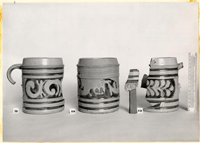 PLATE II
PLATE II
1-3. Gray stoneware "AR" mugs, pp. 10-11.
11
the rim diameter is 4". The decoration on this handled mug consists of molded concentric bands encircling the vessel near its base and extending ¾" below the rim, defining a 2"-wide band between these moldings embellished with a floral pattern on both sides of a squarish medallion, 1 5/8" high x 1 ½" wide, located on the side opposite the handle. The decorative medallion is bordered by a row of raised dots around the letters "AR", surmounted by a crown. Cobalt-blue coloring sets off the two letters, certain elements of the floral design, and alternate bands of molding, above and below. This vessel has been restored and is catalogued as 3A-20-9L.
Plate II, Number 1, catalogued as 3A-22-9L, has substantially the same dimensions and decoration as the mug described above. It lacks, however, the medallion which may have adorned the side opposite the handle.
Plate II, Number 3, possessing a different floral decoration from that upon Numbers 1 and 2, is of substantially the same dimensions; a portion of the "AR" medallion from this mug shows clearly the upper portion of the crown design above the letters, missing from the identical medallion on Number 2. This mug is catalogued as 3A-21-9L.
12Class 1B, Chinese Porcelain:
Chinese porcelain, decorated on both inner and outer surfaces with a characteristic shade of blue and displaying a profusion of patterns, both realistic and conventional, was popular in Williamsburg in the Eighteenth and Nineteenth Centuries. Much of it was manufactured at Ching-tê-Chên, at Kiangsi Province, long known for its ceramics. Chinese porcelain was advertised for sale in Williamsburg as early as 1718. It is possible that Jean Marot was among those who were quick to acquire Chinese porcelain. The inventory of his estate, according to the document admitted to probate on December 16, 1717, included "Glasses & China Cupps", valued at 7 shillings 6 pence. Thirty-three years later, James Shields, who had married Marot's daughter and with her for a few years had operated "The English Coffee House" in this house, also died and his estate was settled. Among his possessions were several items of "China", presumably Chinese porcelain. This inventory showed as "in the Hall", four China chocolate cups, three China bowls, and forty-two China plates; situated "in the Chamber & Kitchen" was a parcel of China; three China dishes and three China butter plates were itemized as "in the Cellar etc"; while twelve China saucers were found "in the Shed". Today, the explorations reveal Chinese porcelain fragments as present on most colonial sites at Williamsburg. Sherds of two cups, one saucer, and four bowls were recovered at this site. Representative sherds appear in Plate I, No. 4.
One bowl of Chinese porcelain, outstanding enough to justify its illustration as No. 8 in Plate XI, ranges in thickness from 2 mm. to 6 m., although its average thickness is 3 mm. Minute particles of black substance are scattered throughout the white body of this ware. The diameter across the rim is 9 ¼". Although the bottom of the bowl is missing, the interior depth is estimated to be approximately 2 7/8". The exterior decoration consists of a fruited pomegranate branch, with other design elements also shown in blue. A 3/8"-wide band, in blue, of geometrical diaper-like designs interspersed with pomegranate fruit, lies within the rim. The edge of the rim bears a narrow brown stripe. This bowl is catalogued as 1B-13-9L.
13Class 2B, Chinese Porcelain (Polychrome Enameled):
The collections from this site include but two examples both plates, of this recognizable type of thin porcelain frequently but incorrectly termed "Lowestoft", characterized by delicate ornamentation, usually of colors other than the "Chinese willowware" blue, and which are applied [on] an overglaze enamel. It is thought that examples of this type of porcelain were present in Williamsburg as early as 1760.
The two plates excavated at this site are rather poor examples of this type of porcelain. Both have basal rims 4 ½" in diameter, and each bears on its base the two concentric circles of under-glaze blue, recognizable as marks distinctive of the Chinese porcelain industry at Ching-tê-Chên. The first of the two plates, catalogued as 2B-18-9L and illustrated as No. 5 in Plate I, has a diameter across the rim of 8 ½", with a marly 1 ½" wide. The rather carelessly done ornamentation in overglaze enamel employs faint green, gold, and russet tones in depicting floral sprays and what appear to be rectangular boxes on low platforms. A scale drawing of this plate appears in Plate III. The second plate, catalogued as 2B-17-9L and shown as No. 6 in Plate I, is decorated in part with a pair of under-glaze blue concentric hair-line circles, approximately 2 5/8" in diameter, centered in the bottom of the platter and incorporated into the floral designs in over-glaze enamel appearing in panels over the inner surface. This floral ornamentation makes use of light green, gold, russet, and a dark brownish red. No rim fragment has been found from which to determine the size of this plate. Its under surface displays a lobed appearance. An underglaze blue character, ideograph, or symbol is centered beneath the base of this plate; portions of another Chinese character occupy a similar position beneath the plate first described.
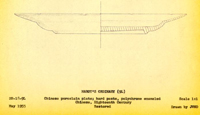 Plate III - Marot's Ordinary - Chinese Porcelain
Plate III - Marot's Ordinary - Chinese Porcelain
Chinese porcelain (polychrome enameled) plate, catalogued as 2B-18-9L, p. 13; also see Plate I, No. 5.
14Class 3B, English Porcelain:
A single example of English porcelain has been found at this site. It may possibly have been produced by the celebrated small porcelain factory at Lowestoft, in operation from 1757 to 1802. This vessel, a mug, is distinctive in that the glaze has disappeared, leaving a surface rough to the touch and revealing a blue-and-white landscape executed in the Chinese manner, but in which all details appear blurred. It Is now impossible to determine whether the absence of glaze today can be attributed to some process inherent in the original manufacture, or to the fact that the fire which destroyed the building on this site in 1858 may have melted and removed the glazed surface from this mug, although other vessels found at this site show no, lack of glaze.
In this connection, the following descriptive reference to Lowestoft porcelain is excerpted from page 268 of George Savage's Eighteenth Century English Porcelain, (N.Y., MacMillan, 1952):
The china made here could rarely be called competent. It is apt to be thick and clumsily potted, The blue often runs and smudges, and pieces with this fault, which most other factories would have condemned out of hand as "wasters", were allowed to be sold which indicates that so much of the production must have suffered from the defect that it was regarded as incurable. This largely applies to the earlier pieces. On later pieces the blue is much improved. The potting, too, improved greatly toward the end of the factory's life, becoming noticeably less clumsy. The glaze was thick and of a greenish tone full of minute bubbles. It lies especially thick inside the foot rim . ...The body is of a creamy color, although the glaze may disguise it.
This mug of English porcelain, possibly made at Lowestoft, was restored from sherds and is catalogued as 3B-1-9L; it is illustrated an Plate III-A. The ware tapers in thickness from 2 mm. at the rim to about 4 mm. or 5 mm. at the basal rim. The color of the paste is white. The diameter across the rim is 3 ¼" and at the base, 3 ¾"; its height is 4 ¾". A vertically attached handle slightly more than a half-inch wide, and now broken off near the side of the mug, would have accommodated three fingers through its loop. There is a slight flare where the side joins the base. The center of the bottom is flat recessed 1 mm. below the edge of a basal rim which is 5/16" wide.
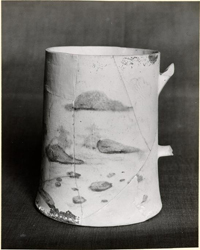 PLATE III-A
PLATE III-A
English porcelain mug (Lowestoft?), p. 14. Height, 4 ¾".
Class 1C, Crude Earthenware:
A great bulk of crude earthenware, manufactured almost entirely in England, was imported into Virginia during the Seventeenth and Eighteenth Centuries. Although some crude earthenware was being produced in the Jamestown area during the Seventeenth Century, as evidenced by recent finds at Governor Sir William Berkeley's "Green Spring" Plantation, the art seems not to have become firmly established at so early a period in the Colony's development. Evidence exists in documents of what must have been another beginning, at Yorktown, in 1732. The industry is thought to have vanished in Virginia with the death two years later of the "poor potter of York", and apparently it was not reestablished to any great extent until after the American Revolution. Ever since that time, earthenware has been widely produced in Virginia.
In addition to the pipkin reproduced in Plate V, the collections from this site have yielded one or two large jugs, a jar, a flat lid, and a large basin of crude earthenware. Representative sherds appear in Plate IV, No. 1.
Plate V, Pipkin of Crude Earthenware:
This red-bodied ware is about 4.5 mm. thick. The rim diameter is 7 1/8", and its approximate height is 6 ½", while the remaining one of the three feet is one inch long. The flattened handle, about 1½" wide, is 3 ½" long. The rim and interior are coated with a clear glaze. Decoration consists of bands of shallow incised lines encircling the vessel's exterior. Scale drawing was reconstructed from sherds catalogued as 1C-8a, 8b, 8c-9L.
- 1.Crude earthenware sherds, p. 15
- 2-13.Delftware sherds, pp. 16-17. No. 2 is plate catalogued as 3C-90-9L, and is also represented in Plate VIII. No. 3 shows two sherds of a plate, possibly of Dutch workmanship. No. 4 illustrates sherd of cup catalogued as 3C-91-9L, also shown in Plate IX, No. 1. No. 8 illustrates exterior of basin, catalogued as 3C-89-9L, also shown in Plate VII. No. 9 shows the exterior of a bowl catalogued as 3C-88-9L, which also appears in Plate VI. No. 10 shows sherds of a saucer catalogued as 3C-93-9L, of which a restored drawing appears in Plate X.
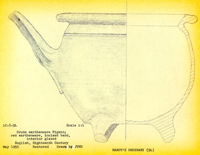 PLATE V
PLATE V
Crude Earthenware Pipkin, page 15.
Class 3C, Delftware:
Delftware, or tin-enameled earthenware, was popular in Western Europe all through the Seventeenth Century. It was imported into the Colony at Jamestown prior to 1650 and retained its popularity there and, in after years at Williamsburg, into the last quarter of the Eighteenth Century. Parts of at least 25 vessels were found at this site, of which 13 were bowls, 4 were plates, with 1 each a cup, saucer, and basin; furthermore, there were 2 large and 1 small apothecary's jars and a small ointment jar. All these were apparently of English manufacture. (Two sherds of a plate that may represent Dutch workmanship show the feet and part of the legs of a standing human figure; see Plate IV, No. 3). Plates VI, VII, VIII, IX, and X supply scale drawings of certain of these vessels, while a representative showing of delftware from this collection appears in Plate IV, Nos. 2-13 and in Plate XI, No. 7.
Plate VI, Delftware Bowl Ornamented in Blue:
Buff-colored ware, approximately 5 mm. thick, The height of this bowl is 3 5/16", its diameter at rim is 6 ¼" while the basal rim measures 3 1/32" in diameter.
The background enamel color is bluish-white; interior decoration consists of a thin blue line encircling the bowl ½" below the rim, and a similar ring near the bottom of the bowl. The exterior bears a pale blue half-inch band at the rim. Overlying this is a row of rayed, festooned designs in a medium blue, encircling the bowl. A band of blue-and-white dashes between hair lines 3/16" apart surrounds the bowl 2 ¾" below the rim, with a band of lozenge-shaped blue forms between lines one inch lower on the bowl. Drawing reconstructed from partially restored bowl catalogued as 3C-88-9L. Also, note photograph of the inverted bowl in Plate IV, No. 9.
Plate VII, Delftware Basin:
Thickness of ware is 4.5 mm.; color, buff. Height of basin at rim is 4"; diameter at rim is 9 13/16"; diameter of basal rim is 3 ½". Rim is everted. Color of enamel is white. Undecorated. Drawing reconstructed from sherds catalogued as 3C-89-9L, and photographed as Plate IV, No. 8.
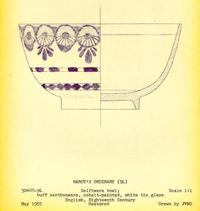 PLATE VI
PLATE VI
Delftware bowl, catalogued as 3C-88-9L, p. 16; also, see Plate IV, No. 9.
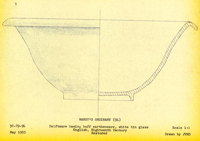 PLATE VII
PLATE VII
Delftware basin, catalogued as 3C-89-9L, p. 16;
Also see Plate IV, No. 8,
Plate VIII, Delftware Plate, Blue Ornamented:
Thickness of body varies from 5 mm. at the marly to 6 mm. at the bottom; color is buff. Diameter at the rim is 9 ¾"; diameter at base is approximately 5 ¼"; height is approximately 1". Color of enamel is bluish-white. No decoration appears on the under side, while the upper surface bears a narrow light-blue line 1/8" within the rim and a similar pair of lines describing a circle 5" in diameter in the bottom of the plate. Darker blue ornamentation consisting of flowers and fruit and clusters of dots covers the area between the outer and inner circles, but separated into panels by vertical tapering bars and triple spirals. Floral ornamentation fills the inner circle, as well. Drawing reconstructed from sherds catalogued as 3C-90-9L. Also, see photograph of decorated interior in Plate IV, No. 2.
Plate IX, Number 1, Delftware Cup, Blue Ornamented:
Ware is buff-colored and is approximately 2 mm. thick; diameter at rim is 2 23/32"; diameter of foot is approximately 1 9/32"; height of cup is approximately 1 5/8". Enamel is white. Dark blue floral designs and stars appear in balanced arrangements in rectangular or squarish panels around the outer surface of the cup, and separated by narrow borders of the same hue. Drawing reconstructed from single sherd, catalogued as 3C-91-9L. Also, see photograph in Plate IV, No. 4.
Plate IX, Number 2, Delftware "Ointment Cup":
This cup is made of buff-colored body, covered with pink-tinged white enamel, completely without ornamentation. Diameter across rim is approximately 1 13/16", and at base, 1 ¾"; height is 1 13/16"; depth of depression is 7/8". Catalogued as 3C-92-9L. Also, see photograph in Plate XI, No. 7.
Plate X, Delftware Saucer, Polychrome Ornamented:
Ware is buff-colored and has an average thickness of 3 mm. Diameter at rim has been computed to be 5 ¼"; diameter of basal rim is 2 11/32"; height is 1". Decoration consists of narrow blue line just inside of rim, and a double line of blue forming a circle 2 1/8" in diameter in the center of the bottom. The entire inner surface is decorated with a red, blue, and green floral motif, wherein the poppy-like bloom in the center and the stems are red. The color of the enamel is white, faintly bluish in tone. Scale drawing is reconstructed from three unconnected sherds, catalogued as 3C-93-9L. Note photograph of sherds in Plate IV, No. 10.
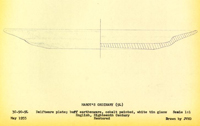 PLATE VIII
PLATE VIII
Delftware plate, p. 17; also, see Plate IV, No. 2.
- 1.Delftware cup, p. 17; also, see Plate IV, No. 4.
- 2.Delftware "ointment cup", p. 17; also, see Plate XI, No. 7.
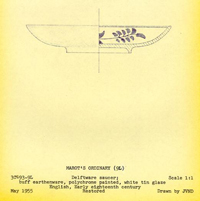 PLATE X
PLATE X
Polychrome ornamented delftware saucer (drawing reconstructed from sherds shown photographically as Plate IV, No. 10), P. 17.
Class 5C, Creamware:
In 1760, Josiah Wedgwood began experiments which were numbered in the hundreds before he had perfected creamware, a greatly improved household ware that was to become the most popular of all English ceramics. Its chief characteristic is a buff body, made of refined clay, possessing in its finished form a creamy tone. Wedgwood's methods were widely copied by other potters, and they contributed directly to the prosperity which within his lifetime came to the Staffordshire ceramic industry. Creamware, also known as Liverpoolware, was exported to America in great quantities. By 1770, it was on sale in Williamsburg. Usually plentiful in collections from Williamsburg sites, only two sherds were found on this site: one was the rim fragment of a chamber pot, and the other was a rim sherd of a plate which had a plain marly, 1 ¼" wide, with an undulant edge, Both fragments appear in Plate XI, No. 1,
- 1.Creamware sherds, p. 18.
- 2.Blue- and green-edged ware sherds, p. 19.
- 3.Hand-painted Staffordshire ware sherds, p. 20.
- 4.Annular ware sherds, p. 21.
- 5.Transfer-printed Staffordshire ware sherd, p. 22.
- 6.Wig-curler, p. 54.
- 7.Delftware "ointment cup", p. 17; also, see Plate IX, No. 2.
- 8.Chinese porcelain bowl sherds, p. 12.
Class 6C, Blue- and Green-Edged Ware:
Almost at the beginning of the third quarter of the Eighteenth Century, English potters had developed a mass-produced, inexpensive white-bodied ware, known from the colors applied to the molded, feather- or shell-decorated edges of plates and other table ware as blue-edged and green-edged ware. This ware is plentifully represented at Williamsburg, where its popularity is thought to have continued well into the first quarter of the Nineteenth Century.
Four plates, a bowl, and a footed vessel of considerable size are identifiable from the sherds found at this site. Examples appear in Plate XI, No. 2.
20Class 7C, Hand-Painted Staffordshire Ware:
Hand-Painted Staffordshire, as a recognizable and frequently attractive ceramic type, was probably first made in England prior to 1775; it appears in Williamsburg excavations for the period after 1781. It remained plentiful and popular through the first quarter of the Nineteenth Century. This ware has a chalky-white body, readily distinguishable from creamware. An apparently colorless glaze was usually employed, but in accumulations such as present near the basal ring, this glaze presents a bluish tint. (In precisely similar circumstances, the glaze on creamware has a yellowish tinge.) A mug, a pitcher, and a bowl are shapes represented by sherds of this ware from this site. For illustrations, see Plate XI, No. 3.
21Class 8C, Annular Ware:
Annular ware is a variant of hand-painted Staffordshire ware which is characterized by liberal use of bands of usually brilliant color, applied over surfaces occasionally ornamented by shallow grooving or by rouletting. Various shades of brown, blue, green and yellow slip were applied in carefully controlled parallel bands, later covered with a transparent glaze. This gaily colored product of even the larger English potteries was in production from about 1810 until near the middle of the Nineteenth Century. The relatively small amount of this ware from this site represented five bowls. Illustrative sherds appear in Plate XI, No. 4.
22Transfer-Printed Staffordshire Ware:
The best known Nineteenth Century earthenware, and the type generally most plentiful in Williamsburg excavations, was mass-produced in England and now usually is referred to as Transfer-Printed Staffordshire. Upon previously fired vessels, engravings often intricate in workmanship, and representing a tremendous variety of designs or scenes, are transferred to the surfaces to be decorated and are printed thereon in blue, mulberry, black or various other colors; further processing gives these decorative designs, scenes, or patterns a lasting quality. The art of transfer-printing on ceramic surfaces was discovered in the middle years of the Eighteenth Century, and it still is widely employed.
Parts of four blue-decorated platters, a pitcher bearing a black design, and a wide-mouthed jar decorated in mulberry color are from this site. None can readily be restored. An illustrative sherd appears in Plate XI, No. 5.
23Class MC, Miscellaneous Pottery:
This collection contains the bottom of a flat-bottomed earthenware mug, 4 7/16" in basal diameter and 1 5/8" high at the break. It is decorated by pairs of narrow, lightly-incised grooves encircling the vessel ½" and 1 1/8" above the base. Ware is tan and quite dense, approaching stone-ware in appearance. Glaze is medium brown, with a lustrous sheen, similar to that employed on Nottingham Ware. (This sherd is not illustrated.)
2. GLASS
Comments on Glass
Although considerably more than an average amount of glass was recovered from the excavation of the Marot's Ordinary site, it is difficult to attribute these particular finds to specific periods of Eighteenth Century occupancy. However, in the light of our certain knowledge that some twenty-four wine-glasses, three tumblers, a decanter stopper, three cruets, two castors, innumerable wine bottles, and a few fragile vials for medicine or perfume, were found at this site, it is interesting to speculate whether or not any of these articles were once owned and used by Jean Marot, who kept ordinary here from 1708 until his death in 1717, or possibly by the second James Shields, proprietor here of "The English Coffee House" from 1745 to 1750. Interest centers upon these two early public-house keepers, since inventories are extant of their estates, enumerating, among other property, certain holdings of glass. Jean Marot's estate, inventoried December 16, 1717, included "Glasses & China Cupps" valued at 7 shillings 6 pence, some three dozen of drinking glasses, worth 15 shillings, and "Bottles", presumably of glass, valued at 8 pounds 10 shillings. The estate of James Shields, inventoried January 21, 1750/1751, mentioned one glass bowl and twenty-eight wine-glasses as present in the hall, while in the bar there were four carboys, presumably of glass, and a case fitted with bottles. Located in the "Chamber and Kitchen" were the following: 2 quart decanters, and 5 glass 25 salts; while in the cellar area were two half-pint decanters and one of one-pint capacity, together with 69 wine-glasses, 6 sweetmeat-glasses, 29 "sullibub"-glasses, 82 jelly-glasses, 6 glass servers, and 10 gross of quart bottles. Located "at the Quarter" was one case fitted with a broken set of eleven bottles. The great increase in amount of glass held by James Shields as contrasted with that which Jean Marot left at his death thirty-three years earlier probably reflects the arrival of more cultured times in the community.
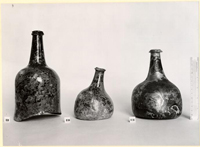 PLATE XII
PLATE XII
1-3. Wine bottles, p. 30.
Description of Glass
An itemized description is furnished of the more significant articles of glass selected from those excavated at this site and illustrated in Plates XII and XIII:
Class G1, Tableware (Wine-Glasses, Tumblers, Decanters, Cruets, Castors, etc.):
Wine-glasses:
Wine-glass, knopped stem. Waisted bowl (fragmentary) on slender 3-knopped stem 2 ¾" long, ending in domed foot (fragmentary). Glass is clear slightly iridescent. G1-19-9L. (Plate XIII, No. 1) [A second bowl and stem fragment of this set is present in the collection.]
Wine-glass, ogee bowl, 2-knopped, air-twist stem. Bowl shows slightly ogeed bulb at base with diameter of 1 3/16". Two knopped stem contains air-twist. Lower part of stem and foot are missing. Glass is clear and brilliant. Over-all length is 4". G1-18-9L. (Plate XIII, No. 2)
Wine-glass, fluted stem, with "tear-drop". Funnel (?) bowl, above inverted baluster stem enclosing a "tear-drop" 1 ½" long, and shaped on the exterior by 8 shallow flutings, tapering downward to the break. Fragment is 3 3/8" long. Glass is clear and shows surface stress lines and some iridescence. G1-33-9L, (Plate XIII, No. 3)
Wine-glass, baluster, "tear-drop" stem. Funnel (?)(fragmentary) bowl on inverted baluster stem, 2" long, enclosing a l" long "tear-drop", standing on a domed, folded foot 2 ½" in diameter. Glass is clear, brilliant, with trace of iridescence in bowl. G1-29-9L. (Plate XIII, No. 4)
Wine-glass, inverted baluster stem. Trumpet (?) (fragmentary) bowl on inverted, hollow baluster stem, 2" long, with slightly domed (fragmentary) foot. Glass is clear and brilliant. G1-23-9L. (Plate XIII, No. 5)
Wine-glass, bowl (ogee shape). Upper part of rim is broken away, and beneath, all except trace of union with stem ½" in diameter. Surface of glass is abraded and slightly iridescent. Fragment is 2" long. Bulbous lower portion of bowl has 1 3/16" diameter. G1-31-9L. (Plate XIII, No. 6)
27Wine-glass, ogee bowl, with "tear-drop". Bowl is slightly ogeed in shape, its bulb having a diameter of 1 1/16", enclosing a badly-formed "tear-drop". Plain stem measures approximately 2 ½" in length, ending in a domed foot. Outer part of foot and of rim of bowl are missing. Surface disintegration shows stress lines and iridescence. Fragment measures 4 ½" in length. G1-30-9L. (Plate XIII, No. 7)
Wine-glass, trumpet (?) bowl, "tear-drop" stem. Trumpet (fragmentary) bowl, of which the bottom is approximately 4" above the foot. Stem has 9/16" diameter approximately 1 ½" above base and has gradual upward taper, with enclosed "tear-drop" 2" long. Outer edge of domed foot is missing. Glass is clear, with a trace of iridescence. Total length of fragment is 4 7/8". G1-26-9L. (Plate XIII, No. 8)
Wine-glass, baluster, "tear-drop" stem. Funnel (?, fragmentary) bowl, on 2 3/8"-long heavy inverted baluster (1 7/16" diam.), enclosing small "tear-drop" and standing on slightly domed (fragmentary) foot, approximately 3" in diameter. Glass is clear, with trace of iridescence. G1-28-9L. (Plate XIII, No. 9)
Wine-glass, 2-knopped stem. Bowl is possibly of straight, tapering shape, with very massive bottom. Stem is 2-knopped, 1 ¾" long. Foot is relatively thin and slightly domed. Upper part of bowl and outer part of foot are missing. Glass is clear and brilliant. Fragment is 3 ½" long. G1-16-9L. (Plate XIII, No. 10)
Wine-glass, stem (baluster). Bottom of trumpet (?) bowl present, with tapering stem rising from double knop, the larger of which encloses a "tear-drop"; base of stem and foot are missing. Glass is clear and brilliant. Fragment is 3 5/8" long. G1-24-9L. (Plate XIII, No. 11)
Wine-glass, (ogee ? bowl), knopped stem. Bowl is possibly ogeed in shape, with heavy basal bulb 1 3/16" in diameter, to which is attached a double-knopped stem; lower end is broken off, as is upper part of bowl. Glass is clear and brilliant, with some iridescence. Fragment is 2 3/8" long. G1-20-9L. (Plate XIII, No. 12)
Wine-glass stem, knopped. Bowl has tapering straight sides, with heavy bottom, resting upon glass cushion 1 1/8" in diameter, with a smaller knop below it. Stem is 1 5/8" long and stands on slightly domed foot. Over-all length is 3 ¼". Glass shows some surface disintegration. Upper part of bowl and outer part of foot are missing. G1-15-9L. (Plate XIII, No. 13)
28Wine-glass, knopped, pinched stem. Bowl is completely missing. Beneath it is a cushion, 1" in diameter, pinched or nipped into 5 prongs or points. Stem is 1 ½" long, with knop touching slightly domed foot, approximately 3" in diameter (outer edges missing). Height of fragment is 2". Glass shows slight iridescence and surface disintegration. G1-27-9L. (Plate XIII, No. 14)
Wine-glass, funnel (?) bowl, with knopped and nipped stem. Base of funnel (?) bowl rests upon merese 1 1/8" in diameter immediately above knop nipped in five spirals, 1" above a smaller knop, forming a stem 1 ½" long, above a slightly-domed foot. Upper part of bowl and outer part of foot are missing. Fragment is 2 5/8" long. Glass is clear, yet with some signs of stress lines and iridescence. NOTE that imprint of jaws of nippers or pincers on spirals produce waffle, effect. G1-34-9L. (Plate XIII, No. 15)
Wine-glass, inverted baluster stem. (Funnel (?) fragmentary) bowl on 2¼"-long heavy inverted baluster base, including 2 knop one of which is 3/8", in diameter and the other, 1" in diameter standing on domed folded foot (intact), 2 ½" in diameter. Bottom of bowl is 2 ¾" above base. Glass is clear, with some surface disintegration. G1-22-9L. (Plate XIII, No. 16)
Wine-glass foot. Domed, folded foot of clear glass, 2 7/8" in diameter, to which is attached shattered end of 9/16" in diameter stem. G1-36-9L. (Plate XIII, No. 18)
Tumblers:
Tumbler (?) bottom. Base of what it probably is a tumbler or waterglass, 2" in diameter, 1 ¼" from base to break. Sides are straight and display but slight outward taper. Surface shows stress lines and pronounced iridescence. Glass is clear. G1-10-9L. (Plate XIII, No. 20)
Decanters:
Decanter stopper. Over-all length of stopper is 2 ¼"; the nearly spherical knob, containing "tear-drop", is 1" in diameter; this was apparently used in decanter or bottle having an inner neck diameter of ¾"; neck constriction measures 9/16". Glass is clear, with slightly milky surface disintegration. G1-12-9L. (Plate XIII, No. 21)
29Cruets:
Cruet. This cruet is intact except for the flaring neck and lip, and for the vertically-placed handle. Volume, 296 cc. Diameter of flat base is 2 3/8"; diameter at constriction 3/8" above base is 1 ¾"; greatest diameter is 2 5/8" at a height of 1 3/8" above the base. The neck diameter is 7/8" and is 3/8" long. A jagged break at 5 1/8" above the base marks the present height of this cruet, at a point where the neck flares toward the lip. A portion of the lower handle attachment is present 1 ½" above the base, with the trace of the upper end of the handle at 4" above the base. Basal rim is nicked in two places. Vessel is of clear glass. G1-4-9L. (Plate XIII, No. 23)
Cruet. (?), base fragment. Diameter of base is 3 5/8"; diameter at constriction 3/8" above base is 2 5/8"; vessel is broken at height of 1"; base has pronounced kick-up. Glass is clear. G1-7-9L, (Plate XIII, No. 17)
Cruet (?), handled. Base 2 ¾" in diameter of what may be a cruet, of which the upper portion is missing 1" above the intact base. Sides are straight, with a slight outward taper. Two handles, one on each side, attached ½" above the base, show pinched ornamentation at point of contact. Surface is abraded and clouded. G1-5-9L. (Plate XIII, No. 19)
Castor-glasses:
Castor (?)-glass. Nine-sided basal fragment of glass insert approximately 1 ¼" in diameter, and 1 5/8" high to the break. This apparently has gone through a fire that has in part melted the glass, causing the shape to run. This is a Nineteenth-Century type, and possibly it was present in the building destroyed by fire on this site in 1858. This glass is clear, although its surface is now-dark gray, and it is very heavy. G1-11-9L. (Plate XIII, No. 22) [A second fragment, less identifiable than this, represents what probably was a similar piece, also fire darkened.]
30Class G2, Wine or Other Beverage Bottles:
Wine Bottles:
Wine Bottle, fragmentary. Bottle has 4 7/8" basal diameter, with a diameter 4" higher, at the shoulder, of 4 ¾" height is 9 ¼"; neck is 3 ¾" long, taking a ¾" stopper. Lip flares slightly; neck ¼" below it is encircled by a ring 7/8" in diameter. Bottom is missing. Color is dark green, and iridescent. G2-10-9L. (Plate XII, No. 1) 1760?
Wine Bottle. Measures 5 11/16" in diameter, with a height of 7"; kick-up is 1 5/8" deep; neck is 3 3/8" long, and takes a ¾" stopper; flange-like ring ¼" below lip is 7/8" in diameter. Color is dark green, highly iridescent. Intact. G2-8-9L. (Plate XII. No. 3) 1730?
Wine Bottle. Bottle is 4 ½" in diameter, with a height of 5 ¼" kick-up is ¾" deep; neck is 2 ¼" long, and takes a 5/8" stopper; flange-like ring at lip is 1 ¼" in diameter. Color is dark green. Surface is greenish-tan. Neck is asymmetrical. Intact. G2-3-9L.(Plate XII, No. 2) 1730?
31Class G3, Vials (Medicine, perfume), and other Fragile Containers:
Necked vial, intact. A round bottle, 15/16" in diameter, 2 ½" high, with neck 5/16" long x ½" in diameter. Neck takes stopper 7/16" in diameter. Base has ¼" kick-up. Flange-like lip shows slight break in side. Glass is light-green in color, and iridescent. G3-3-9L. (Plate XIII, No. 25)
Bottle neck. Neck ½" long of light-green glass bottle with flaring lip 1 ¼" in diameter, and taking stopper ½" in diameter. Iridescent. Glass is 2 mm. thick. G3-4-9L. (Plate XIII, No. 26)
Bottle neck. Neck 2 3/16" long, formed of light-green glass, taking a 5/8" stopper. Bottle measures 3 ½" in diameter at the shoulder. Glass is approximately 1 ½ mm. thick at the shoulder, although the neck is thicker. Fragment is 3" long. G3-7-9L. (Plate XIII, No. 27) [Possibly an olive oil bottle; dating uncertain.]
Funnel-like green-glass tubes. Four fragmentary tubes of light-green glass, extremely fragile. Length of fragments varies from 1 ½" to 2 ½", and thickness from .5 mm. to 1.5 mm. There is a taper of approximately ¼" to 1" of length. These possibly are neck fragments of very fragile and delicate bottles. G3-11-9L. (Plate XIII, No. 24)
3. METAL
Comments on Metal
Most of the metal recovered from excavations at this site quite apparently was builder's hardware, comprising such sturdy items as hinges, both H-L and strap types; bar-keeps; hasps; pintles; staples; locks; a key, and the like, all parts of the fabric of structures here, standing at various times since the first occupancy of this site. Some of the metal artifacts related more than the foregoing to activities associated with the site, and these are slightly more revealing. The presence among these artifacts of a brass-and-iron drop-handle may relate to a coach. Other reminders that the stable was not too far from the house are the stirrup, terret, and part of a saddle-tree among this collection. The finding here of brass or bronze wine-cocks may take on more significance than their number alone would entitle them to, considering the importance of such cut-off valves in drawing off the contents of beverage casks kept in the bar or cellar of a public house. A good liquid inventory is shown as on hand at the time of settling up of the estates of Jean Marot in 1717 and of the second James Shields in 1750/1751, much of it specifically listed as in bottles, but quite probably a goodly portion of it retained in bulk. The Shields inventory in one place listed "6 brass cocks", and in another place noted the presence of "1 brass cock". The Marot inventory specifically included "4 narrow hoes" and "1 Trevett" 33 (trivet?); the Shields property listed two new narrow hoes. These items are singled out because narrow hoes as well as broad hoes are among the finds, and incidentally, a trivet, by no means an unusual object in an early kitchen, was uncovered at this site. While pewter ware was included in both the Marot and Shields inventories, the only object of this metal uncovered was a single spoon bowl. A spoon-handle of iron and a brass ladle are culinary items uncovered here. Other interesting tools or implements among the excavated artifacts are a large trident, some axes, three-branched gimlets, a pair of tongs and parts of a scythe. Also of interest is part of an ice-skate.
Description of Iron
A selection of the iron objects found during excavation of the Marot's Ordinary site is furnished in Plates XIV, XV, XVI, and XVIII. These comprise 51 illustrated items, described in considerable detail in this section. They include: 3 of the 9 hoes found; all 3 of the axes that were unearthed; 2 of 3 3-branched gimlets; 3 of 4 staples; 6 of the 8 spikes found; 3 of 8 H-L hinges; 3 of 4 strap hinges; all 5 of the locks unearthed; and both iron ties utilized for binding together bundles of iron rods. Other items selected for description and illustration represent the only examples present in the collection.
While all these are presumed to be Eighteenth Century types, it cannot be clearly proved that some may not have been made during the succeeding years that this site was occupied. However, in assembling this material for study, an effort was made to exempt from inclusion specimens clearly of Nineteenth Century origin; such pieces were retained in non-current storage.
The research report upon this site reveals that a portion of this area was leased in 1770 to John Draper, a farrier and blacksmith. Possibly his shop stood on some part of this lot. In 1858, the building on this site was destroyed by fire. In 1861, and for some years thereafter, this site was identified with a carriage-making shop operated by Thomas Moss, and by a son who succeeded him in that enterprise. It is possible that some of the specialized tools of each of these periods of occupancy may be included among the iron artifacts whose description follows:
35Tools and Implements:
Hoe (fragmentary). Over-all height of hoe-blade inclusive of the embedded eye is 8 ½"; width of blade is 9 ¾"; eye accommodates handle 2 ½" in diameter; strengthening rib extends approximately 3 ¾" below eye. Edge of blade is badly eroded. Catalogued as 2-497-9L. (Plate XIV, No. 1)
Hoe. Over-all height of hoe-blade inclusive of the embedded eye is 10 7/8"; width of blade is 5 7/8"; eye accommodates handle 2 ¼" in diameter; depth of eye is 2 ¼". A strengthening rib, 1" wide below the eye, extends 5 ½" down the center of the blade. Just below the eye, two touch-marks of shield shape can be made out on the rib, but not clearly. Metal varies in thickness from 4 mm. (near the eye) to 1 mm. (at the blade). 2-501-9L. (Plate XIV, No. 2)
Hoe. Blade of hoe is 5" wide x 4 5/8" high, as nearly as can be determined because of excessive rusting away. Blade is about 2 mm. thick. Welded to the center top of the blade and rising above it ½" is a 1 3/8" eye for the handle. This eye is made of a strap 5 mm. thick and 1 7/16" wide. 2-485-9L. (Plate XIV, No. 3)
Axe. Over-all length from poll to blade is 7 5/8"; maximum width across blade is 4 ¾"; cross-section of poll measures 2 ¾" x ¾"; width through eye is 3 ½"; eye measures 2 ¼" x 5/8"; weight is 2#10 ½ oz. Outer 1 ½" of blade shows ridges indicating special hardening. 2-502-9L. (Plate XIV, No. 4)
Axe. Over-all length from poll to blade is 8"; maximum width across blade is 4 ¼"; cross-section of poll is 2 3/8" x 1 ½"; width through eye is 3 ¼"; eye measures 2 ¾" x 1 1/8" and commences ½" from poll-end of axe; weight is 3#. 2-511-9L. (Plate XIV, No. 5)
Axe. Over-all length from poll to blade is 10 ¾"; blade is 2 ½" wide; poll measures 2" x 1 ½" in cross-section; eye measures 3" x 1 ¼" and commences 3/8" from poll-end of axe. Face of axe is approximately 9/16" thick; weight is 3#6oz. 2-509-9L. (Plate XIV, No. 6)
Pincers or Tongs (fragmentary). Over-all length is 5 ¼"; distance from tips of jaws to hinge point is 1 1/8"; width of jaws is 3/8". Condition, poor. 2-514-9L. (Plate XVII, No. 8)
- 1, 2, 3.H-L hinges, p. 42.
- 4, 5, 6Staples, p. 40.
- 7.Hasp, p. 44.
- 8, 9, 13, 14.Strap hinges, pp. 42-43.
- 10.Pintle, p. 43.
- 11.Bar-keep, p. 39.
- 12.L-shaped hook, p. 40.
- 1.Stirrup, p. 37.
- 2.Terret, p. 37.
- 3.Saddle brace, p. 37.
- 4, 5, 6, 7, 10, 11.Spikes, pp. 40, 41.
- 8.Coupling (?), p. 37.
- 9.Hook, p. 39.
- 12.Structural brace, p. 37.
- 13, 14.Tie irons, p. 45.
- 15.Scythe blade, p. 36.
- 1.Key, p. 44.
- 2, 3.Padlocks, p. 44.
- 4.Trident, p. 36.
- 5, 6, 7.Rim-lock bolts, p. 44.
- 8.Pincers or tongs, p. 35.
- 9, 10.Three-branched gimlets, p. 36.
- 11.Scythe handle, p. 36.
- 12.Bolt (?), p. 41.
- 13.Spoon handle, p. 38.
- 14.Two-tined fork, p. 38.
- 15.Warming rack support, p. 38.
- 16.Ice skate, p. 45.
Gimlet, 3-branched. Mounted on the end of each of three equidistant branches, 2 ¾" long and approximately ½" in diameter, is a 2-grooved gimlet, tapered in shape, and approximately 3 ½" in length from its tip to the beginning of the grooving. The three gimlet-heads are of various sizes, and the points of two have been broken. (Also see 2-505-9L; 2-508 is not illustrated) 2-507-9L. (Plate XVII, No. 9)
Gimlet, 3-branched. A 2-grooved gimlet, as in the case of 2-507-9L and 2-508-9L, appears to have been mounted on each of three equidistant branches of this tool. The branches are about 3" long, with a flange marking the beginning of the gimlet. The one well-preserved gimlet-head on this tool is 2 5/8" long and apparently bores a ½" hole. Each branch measures approximately 7/16" in diameter. A 3/16" hole perforates the flattened area at the center of the tool, from which the three branches emerge. 2-505-9L. (Plate XVII, No. 10)
Barbed Trident, possibly used as Fish Spear or as Roasting Fork. Length, over-all, 14". Each branch is 5 ¼" long, squared in cross-section, and ending in a single barbed point measuring 7/8" on its side. Outer points are approximately 3 ½" apart at their tips and 5" apart at their base ends. Shaft is 7 ¾" long, is squared, and measures ½" on a side 6 ½" from the tapered, pointed tang end. At this heaviest point there is welded to it and almost flush with its surface a cross-bar ¾" long, 3/8" x ¼4" in cross-section. A ¼" x 1/8" slot perforates the tang 1 ½" from its end. The squared corners of the tang are gashed at intervals for firmer socketing to the handle. 2-506-9L. (Plate XVII, No. 4)
Scythe Handle. Over-all length is 7 ¼"; eye is 1 ¼" wide and accommodates handle 1-½" in diameter; spike is 4-sided and extends at a right angle from this sleeve in a tapering tang ending in a sharp point. Condition, good. 2-498-9L. (Plate XVII, No. 11)
Scythe blade (fragmentary). Over-all length is 14 ½" from intact shank end to break in blade; back of blade measures approximately 5/16" wide; distance from it to edge of blade is approximately 11/16". Condition, fair. 2-517-9L. (Plate XVI, No. 15)
37Harness and Horse Furniture:
Stirrup, standing 5" high, with bottom-piece 4" long, split to form an oval aperture 3 3/16" long x 1" wide, forged of squared stock approximately 3/16" thick, of varying width, and forming a loop at the top accommodating a strap 1 1/8" wide. Condition, good. 3-395-9L. Plate XVI, No. 1)
Terret. Over-all length is 3 3/8"; ring is 7/8" wide x about 3 mm. thick, forming rectangular aperture 1 9/16" x 1 3/16" on a side; flange is tapered in cross-section and is approximately 1 3/16" in diameter, surmounted by two encircling ridges with a diameter of approximately 5/8"; lower brad or tap for fixing terret is 5/16" thick x 5/8" in diameter, and is ¾" below the tapered flange. Terret is close-plated with silver. Condition, fair. 3-402-9L. (Plate XVI, No. 2)
Saddle Brace. U-shaped iron bar, measuring in cross-section ¼" x 7/8" at its center and thinning out to a thickness of approximately 1 mm. at each end. The length, following the curve, is 10 ¼", while the distance is 6 ½" between the ends. Two holes, 1 ¼" apart, are centered near each end for attachment to another, inner member. A 1 ½"-long brad, about 1/8" square, remains in place in one of these perforations which are 3/16" in diameter. 3-397-9L. (Plate XVI, No. 3)
Coupling (?). U-shaped rod of ¼" iron, measuring 7" in overall length, each end ending in a ring 3/8" in diameter (interior), or 7/8" in external diameter. 3-400-9L. (Plate XVI, No. 8)
Structural Brace (?). This is a ¼" rod, measuring approximately 14" in over-all length, bent to form two smooth curves, but not both in the same plane. One end is broken off, while the opposite end is flattened out and is broken through the eye of a screw-hole showing tapering on one side. It is possible that this was used as a structural brace in a carriage or other vehicle. 3-401-9L. (Plate XVI, No. 12)
38Household Hardware:
Spoon handle. Over-all length of fragment is 8 ½", tapering from ¼" width near the spoon-bowl to 1 1/8" at the broken outer end. 4-439-9L. (Plate No. XVII, No. 13)
Fork, 2-tined (fragmentary). Over-all length of 3 5/16"; shaft measures 2" from handle to branching of fork tines, and shows graceful tapering of shape, with ornamental grooving; its diameter (maximum) was approximately 5/16". Fragment 7/8" long remains of center tang in handle; 3/8" long fragment of one tine still remains. Condition, poor. 4-430-9L. (Plate XVII, No. 14)
Warming Rack Support. This is a broken piece representing one leg and 8 ¼" of one end of an end or cross support for a rack drilled with 3/16" holes 1 ¼" apart. The top of the rack would be 2" above the level represented by the foot. Made from iron 11/16" x 3/32", while a cross-section of the leg is 1/8" x 5/16". (This fragment is broken into two pieces, a and b mounted for support on a wooden backing.) 4-440-9L. -(Plate XVII, No. 15)
39Builder's Hardware:
Bar-keep, or retainer for holding in position a horizontal bar to secure a door. Forged from a rod, squared in cross-section and measuring ½" x 3/8", with a vertical member 3 ½" high and bent at a right angle to form a tapering squared member 6 ½" long. Condition, good. 6-289-9L. (Plate XV, No. 11)
Hook. Forged of a squared bar ½" x 3/8" in cross-section, U-shaped in profile, the depth of the U measuring 2", with a 5/8" aperture at the top. The point of the hook is tapered and bent Outward at the top, while the opposite end is extended 1 ¼" to an end 3/16" in cross-section, and is bent at a right angle to the vertical member of the U, probably for driving into a beam. Condition, good. 6-290-9L. (Plate XVI, No. 9)
40Nails, Spikes:
Hook, L-Shaped. Length of shaft is 4 ¼"; arm is approximately 1 ½" long; cross-section is ¼" x 3/16". Condition, fair. 7-395-9L. (Plate XV, No. 12)
Staple. This is formed of iron measuring in cross-section ½"x ¼"; one leg possibly unbroken, is 4 ½" long; internal measurement at the top shows the legs to be 1 ¾" apart; shorter (broken) leg is 2 ¾" long. 7-402-9L. (Plate XV, No. 4)
Staple. Formed of iron 3/8" x ¼", with each leg 2 ½" long, the flat bar of the staple being 2 ½" long, but with an internal length between legs of 1 ¾". 7-401-9L. (Plate XV, No. 5)
Staple. Over-all length is 6 ½"; the center 3 ½" portion is ½" x 1/8" in cross-section, while the remaining length has been forged on each end to a sharp point. Condition, fair. 7-391-9L. (Plate No. XV, No. 6)
Spike. Over-all length is 8 ½"; formed of a square bar, slightly tapering, measuring approximately ½" on a side; end is broken off, while head is 15/16" x 7/8" on a side, with a ¼" thickness. 7-399-9L (Plate XVI, No. 4)
Spike Over-all length is 5 3/8"; cross-section measures 3/8" x ¼" near head and tapers to a blunt point; bead is flat and measures ½" on a side. Condition, good. 7-390-9L.(Plate XVI, No. 5)
Spike. Over-all length is 5 3/8"; shaft is about 5/16" in diameter; head is roughly square and measures 7/8" x ¾" with 1/8" thickness. Condition, very poor. 7-393-9L. (Plate XVI, No. 6)
Spike, fragmentary. Over-all length from head to broken end is 12 ¼"; squared shaft measures 13/32" on a side; head is approximately 1 1/8" x 5/8" on a side and is about ½" thick; neck is slightly worn down. 7-400-9L. (Plate XVI, No. 7)
Spike. Over-all length is 6 3/8"; shank is 3/8" on its squared sides near the head of the spike, tapering to a sharp point; head measures ¾" x 5/8", and is approximately ¼" thick. Condition, fair. 7-397-9L. (Plate XVI, No. 10)
41Spike. Over-all length, 7"; a cross-section of the squared shaft near the head is 7/8" x ½"; lower 2/3 of spike is poorly preserved. Head of spike measures 1 ¼" x 7/16" and shows a certain amount of battering. 7-398-9L. (Plate XVI, No. 11)
Bolt. Object of unknown use, 6" in over-all length. Shaft is approximately ¼" in diameter. At one end there is a heavy ring, ½" in diameter having an inner diameter of 3/16". Next to the ring is a ¾" flange, badly preserved. The remaining 5 ¼" of length is very badly rusted away. The final 2 3/8" of the bolt show clearly defined threads, 1/8" apart, with a count of 10 per inch. Condition, poor. 7-396-9L. (Plate XVII, No. 12)
42Hinges:
HL-Hinge. Vertical member is 11 7/8" long; width varies from 1 ¾" to 1 7/8". Horizontal member is 9 ½" long x 1 1/8" (approximate width). Perforations of ¼" diameter occur on vertical member at intervals of from 2 ½" to 3", and on the horizontal member approximately at 4" intervals. Hinge-pin is 3 5/8" long. Metal is 2 mm. thick. Condition is very good. 8-632-9L. (Plate XV, No. 1)
HL-Hinge. Vertical members measure 10 5/8" in length x 1 1/16" wide, while the horizontal member is 15/16" wide and with broken-off tip, now only 4 ¾" long. Perforations ¼" in diameter are roughly centered along the mid-lines of the vertical members at intervals of from 2" to 3", while they are 4 ¼" apart on the horizontal member. Hinge-pin is 3 5/8" long. Metal is 2 mm. thick. 8-626-9L. (Plate XV, No. 2)
H or HL Hinge fragment. Vertical members (tips broken off) were 6 1/8" long x 13/16" wide; hinge-pin, intact, is 2" long. Perforations are approximately 1 ¾" apart. [Paired with virtually identical 8-627-9L - not illustrated-.] Head of hand-made screw that was found in this hinge is retained with the hinge. 8-624-9L. (Plate XV, No. 3)
Strap Hinge. Vertical member is 5 ½" long x 1" wide. Length of horizontal member is 10". Hinge-pin is 1 ¾" long. Vertical member has 5 unevenly placed, beveled 3/8" perforations; horizontal member has 3 perforations, 4" apart, also beveled, of ¼" diameter. Metal varies in thickness from 2 mm. to 4 mm. 8-629-9L. (Plate XV, No. 8)
Strap Hinge fragment. Over-all length, 9". Hinge was approximately 2" wide at hinge-pin end and tapered gently to an end of undeterminable shape beyond the present end of this poorly preserved fragment. Opposite end accommodates a ¾" pintle or hinge-pin. Two regularly-formed perforations 5/16" in diameter near the center line of the strap are 2 1/8" apart. 8-622-9L. (Plate XV, No. 9)
Hinge fragment. Vertical member is 14" long x 1 ¾" wide. 5/16" perforations are near the mid-line of this member, at intervals slightly greater than 3". Hinge-pin, intact, is 4 1/8" long. Metal is 3 mm. thick. 8-625-9L. (Plate XV, No. 13)
43Strap Hinge. Over-all length is 19 ¼". Width at pintle sleeve is 1 9/16". Fits over pintle ¾" in diameter. Perforations of ¼" diameter, apparently beveled, form a group of three near the hinge, with a fourth hole 6" distant from the nearest of this group. Average thickness is 4 mm. Condition, fair, 8-630-9L. (Plate XV, No. 14)
Pintle, Length of horizontal member is 5 1/8", with a cross-section measuring ½" x 3/8" slightly pointed at the tip; vertical member is 3 ¼" long, slightly pointed at the tip, with a maximum diameter of ½". 8-595-9L. (Plate XV, No. 10)
44Locks and Keys:
Hasp. Over-all length, with one end rounded and having eyelet 3/8" in diameter, with at the opposite end a 2 ½"-long slot, 1" wide at middle, and a tip curled back. Cross-section of shank is 9/16" wide and 4 mm. thick. Hasp is bent in middle, almost at a right angle. 9-790-9L. (Plate XV, No. 7)
Key. Length, 5 7/8"; shaft is 4 5/8" long; loop handle is 2 ¼" in breadth. 9-805-9L. (Plate XVII, No. 1)
Padlock. Length is 4 ¾" while width is 3". It is 1 ¾" thick from front to back. One end is rounded, the other flat. Parts of a double back remain on one side. 9-806-9L. (Plate XVII, No. 2)
Padlock. Over-all length is 4"; greatest width is 3"; thickness is ¾"; curved locking member is 3/8" in diameter; fitted with brass key escutcheon and had pivoted lid over it. 9-808-9L. (Plate XVII, No. 3)
Rim-lock Bolt. Length is 4 3/8"; bolt is ¾" long, with cross-section 1" x 3/8"; attached to center of bolt and extending in its plane is shaft ¾" wide x 3 ½" long, slotted and notched. Other portions of the lock mechanism are attached to the bolt. 9-809-9L. (Plate XVII, No. 7)
Rim-lock Bolt (fragment). Length of fragment is 4 ½"; bolt is 1 ½" long, with cross-section of 1 9/16" x 5/8", to which is attached a metal plate 1 5/8" wide x 3 mm. thick. Condition is poor. 9-807-9L. (Plate XVII, No. 5)
Rim-lock Bolt (fragment). Length is 6"; bolt is 1 ¼" long, with cross-section 1 1/8" x ½", with a prolongation 1 3/16" wide x 3/32" thick extending in line with the bolt's plane and flush with one face. Projections to engage the bolt are intact on one side. 9-804-9L. (Plate XVII, No. 6)
45Miscellaneous:
Tie for bundle of rods. Rod of 3/16" iron has over-all length of 16"; one end is bent abruptly back 2" from the end, and the remainder forms a U-shaped curve, measuring 6" across the opening of the U. Possibly used as a "tie" for a bundle of iron rods. 10-165-9L. (Plate XVI, No. 13)
Tie for bundle of rods. Rod measures 11 ¼" in over-all length, formed of 1/8" x 5/16" stock, bent in an almost complete circle, with a 2" long end bent at a 90° angle; apparently, a similar bent back end has been broken off the opposite end. 10-163-9L. (Plate XVI, No. 14)
Ice Skate. Fragment of ice skate, 9 ¼" in over-all length. Runner edge is 3 mm. wide. Runner measures 13/16" from flat bottom edge to the much thinner upper edge. Front tip of runner narrows and curves gracefully upward and back to end in a thickened tip 2 ½" above the plane of the runner edge. 10-164-9L. (Plate XVI-.I. No. 16)
Description of Brass and Bronze
Four wine-cocks of bronze, of which two are illustrated in Plate XVIII and described in this section, were excavated at Marot's Ordinary. One, equipped with a removable key, is of unusual construction. A shallow brass ladle, suitable for kitchen use, and a brass knob or finial, together with a brass drop-handle, possibly employed on a coach-door, are the remaining items of bronze and brass recovered at this site. A description follows.
47Bronze Wine Cocks:
Bronze Wine-Cock with Detachable Key. Over-all length is 6 1/8"; shaft is 7/8" in greatest diameter at a distance of 2 7/8" from the tapered end driven into the bung-hole, with that end of the tube possessing a diameter of ½"; in the opposite direction the taper is more pronounced, toward the vertical barrel of the wine-cock. Its upper diameter is 7/8"; the lower diameter is 11/16". The curved down-spout is 8-sided, with "VIII" stamped on one side; tip of spout has ½" diameter. Concentric grooves decorate the vertical barrel. A removable key 2 ¾" long, having a hollow, 3-sided head, fits over a recessed 3-sided plug, well protected against use by any other than this key. Catalogued as 4-38-9L. (Plate XVIII, No. 1)
Bronze Wine-Cook (fragmentary). Over-all length is 4 ½" from broken end of shaft to broken mouth of spout; greatest diameter of shaft is 13/16", at a point 1 ¼" from center line of vertical barrel, which is 1 3/8" high. Total height of valve assembly is 3 ½" ending in a gracefully curved "handlebar" cross-piece, 1 5/8" long, and stamped on its shaft with "TT". 4-39-9L. (Plate XVIII, No. 2)
- 1-2.Bronze wine-cocks, p. 47.
- 3.Knob or finial, p. 49.
- 4.Ladle, p. 48.
- 5.Carriage (?) drop-handle, p. 49.
- 6.Pewter spoon bowl, p. 50.
Household Utensils:
Ladle (fragmentary). The over-all length of this fragment of bowl and handle is 5 ¼" . Formed from sheet brass 2 mm. thick, the handle is ½" wide at its junction with the bowl; 3 ¼" farther out, where the handle is broken off, its width is 7/16". The bowl is broad and shallow. Its width was 2 7/8" at a distance from the handle of 1 ¾"; its approximate depth there was ½". No decoration observed. 11-39-9L. (Plate XVIII, No. 4)
49Hardware:
Carriage (?) Drop-Handle. Over-all length of shaft from brass hinge-joint to end of squared iron post is 3 ¾". Brass fitting consists of cast escutcheon or flange 2 3/8" in diameter, from the center of which rises a 11/16" x 5/8" squared base for the ¾"-long immovable portion of the hinge-joint, equipped with an iron pin 5/8" long, to which is attached the broken end of the drop-handle. From the socket on the reverse side a square 7/16" iron shaft tapers slightly toward its shaped tip and to which portions of a 1"-square iron tap adhere 1 ¾" back of the brass escutcheon or flange and ¾" from the slightly-pointed tip. Brass was close-plated on its outer surface with silver. 12-68-9L. Plate XVIII, No. 5)
Door-Knob (?), or possibly a Finial. Knob is oval, 1 5/8" x 1 7/16", and is approximately 7/8" thick. This hollow knob is Joined by a neck 3/8" in diameter x ¾" long to a flaring circular flange 13/16" in diameter. A square hole 5/16" on a side is centered on the flat base of the flange, and through it an iron spike 2 ¼" in present length projects. The presence of badly-rusted iron particles adhering to the center of the top of the brass knob may indicate that this object is an element of a finial, as an additional element could be attached here to an iron rod passing along the center axis of this knob. 12-69-9L. (Plate XVIII, No. 3)
Description of Miscellaneous Metals
The only metallic object from this collection other than artifacts of iron, brass, or bronze was a pewter spoon fragment, whose description follows.
Spoon Bowl (fragmentary). Length of bowl is 3"; width is approximately 1 5/8". Part of bowl has crumbled away, and there is a break at juncture with handle. A strengthening center rib extends 2" along bottom of spoon bowl from handle. Maximum depth is approximately 3/8". Condition is poor. MM-2-9L. (Plate XVIII, No. 6)
4. STONE AND BRICK
Comments on Stone and Brick
Several portions of what appear to have been the original circular stone steps were found during excavations and have provided the basis for the detail of the entrance steps of the reconstructed Marot's Ordinary erected on the site in 1954. Paving slabs encountered on the lot were similarly utilized in surfacing certain areas.
Two small, architecturally shaped mantel (?) fragments, 3" and 2 ¼" in length, respectively, have furnished guidance in the reconstruction of mantels in the present structure. These fragments are illustrated as Numbers 1 and 2 in Plate XIX. Portions of a marble slab, approximately 1 ¼" thick and, although broken into several parts, having an area of about one square foot, show discoloration. Particles of shell in the mortar cling to the better preserved but less smooth under surface. This appears as Number 4 in Plate XIX. A dark gray schist-like soapstone molding that possibly was employed as a vertical panel beside a fireplace in the house constructed here following the 1858 fire is 1 ½" thick, 4 ½" wide, and is broken off 5 ¼" from the end of the slab; this is shown in Plate XIX as Number 3.
A fair sample of brick was saved from the Eighteenth Century structures excavated on this site. The main house standing here in 1708 continued in existence until its burning in 1858. The following tabulation gives length, width, and thickness in inches 52 and fractions thereof, together with comments copied from the labels attached by the field archaeologist to each sample. Comments concerning color, however, have been added after laboratory examination, and they are admittedly subjective.
Brick Samples Recovered from Marot's Ordinary
| Sample No. | Length | Width | Thickness | Comments on Each |
|---|---|---|---|---|
| 1 | 9 ¼ | 4 ½ | 2 5/8 | East chimney of main or center portion of building. This chimney has basement fireplace. Color: light red. |
| 2 | 9 ¼ | 4 ½ | 2 5/8 | Rear or south wall of center portion. (Rear basement wall.) Color: brownish-tan. |
| 3 | 8 ½ | 4 1/8 | 2 ½ | Front or north wall of center portion. (Front basement wall.) Color: dark salmon-brown. |
| 4 | 8 ¾ | 4 3/8 | 2 ¼ | Still-house foundation. Color: salmon-brown. |
| 5 | 9 | 4 ¼ | 2 ¼ | Dairy foundation. [A second brick of this sample is 2 ½" thick.] Color: dark brownish-red. |
| 6 | 9 ¼ | 4 ½ | 2 5/8 | East wing foundation. Color: light brownish-red. |
| 7 | 8 ¾ | 4 | 2 7/8 | Kitchen foundation. Color: medium red. |
| 8 | 8 5/8 | 4 | 2 ¼ | West chimney of main or center portion of building. This is a double fireplace on first floor. Color: red, and salmon-brown. |
5. MISCELLANY
Comments on Tobacco Pipes and Wig-Curlers
The site of Marot's Ordinary yielded a very large quantity of pipe-clay tobacco pipes. While one or two are of early Eighteenth Century design, by far the largest proportion of those recovered are types and shapes characteristic of the latter half of the Eighteenth Century.
A fuller discussion of the more than 600 cu.in. of pipe fragments from this collection must await the return of these and other collections of pipes currently being studied by members of the Archaeological Society of Delaware.
Five pipe-clay wig-curlers were found at this site, displaying a range in lengths of from 2 7/16" to 3 ¼", and in diameters of the shaft at their midpoints from 7/16" to 5/8". Impressed upon the flat end of one of these are the letters "WB", surmounted by a coronet. The description of the wig-curler selected for illustration is as follows:
Wig-Curler. The length of this artifact is 3 ¼". The mid-point of the shaft is 5/8" in diameter, while 3/8" from each end, the shaft swells slightly to a diameter of ¾". Each end is flat, and is ½" in diameter, without decoration. The surface of the mid-portion is slightly abraded to a width of about 3/8", probably marking where the hot curler was picked up by tongs. Made of white pipe-clay. W-9-9L. (Plate XI, No. 6)
Comments on Bone-Handled Cutlery
Three examples of bone-handled tableware were excavated at this site, and all three are apparently Eighteenth Century types. Two of the three, parts of a knife and of a fork, are illustrated in Plate XX.
One, a table fork, has a plain bone (or ivory?) pistol handle, formed of two plates each 2 11/16" long, and attached by three iron pins to the flat iron shank which extends from the butt the full 6" length of the fork. There are two tines, each 1 ½" long. Catalogued as 04-3-9L, this fork is illustrated in Plate XX, No. 1. The other piece of tableware, a knife handle with portions of the blade still attached, measures 5" in over-all length. The handle is made of two plates of bone, each 3 ½" long and 1 1/8" in maximum width near the butt end, where each plate is 3/8" thick. Diagonally applied scorings ornament each outer side of each plate. A thin metal butt plate originally extended across the end of the knife. Down the center of the handle there extends the flat shank of iron which, beyond the handle, becomes the knife blade. This is catalogued as 04-4-9L and illustrated as Plate XX, No. 2.
(Another handle, of the same type as the two specimens already described, is broken 2 ½" from the butt end and is without ornamentation.)
